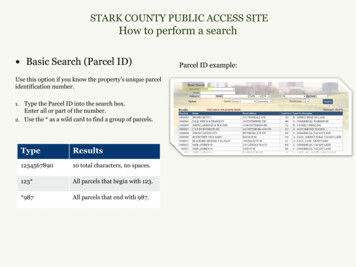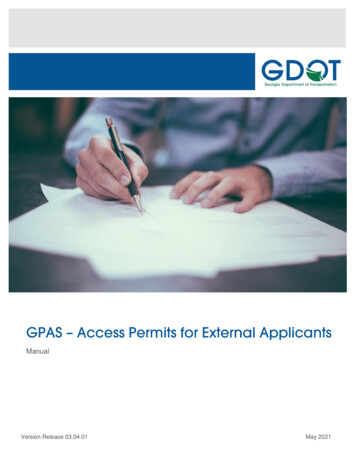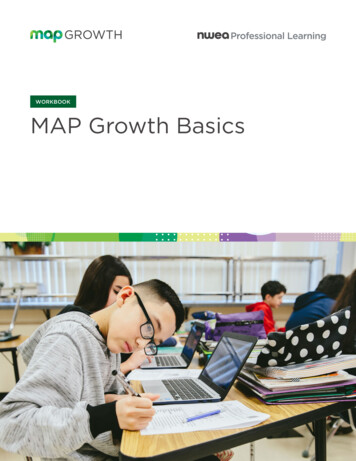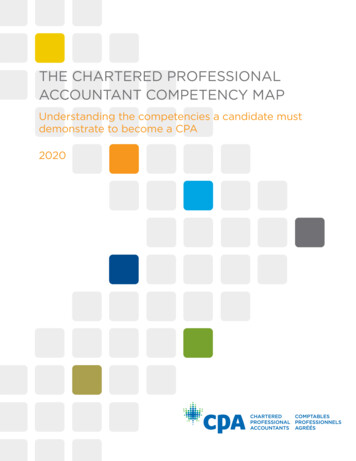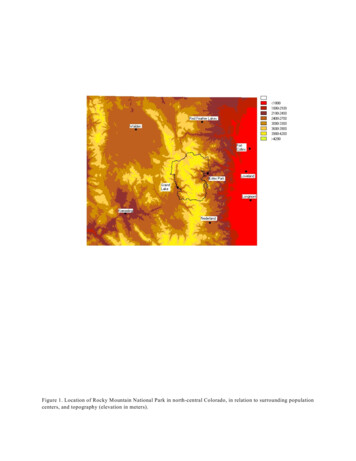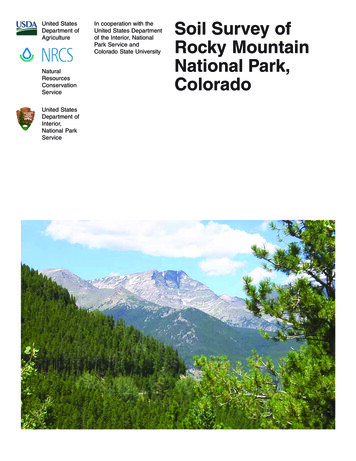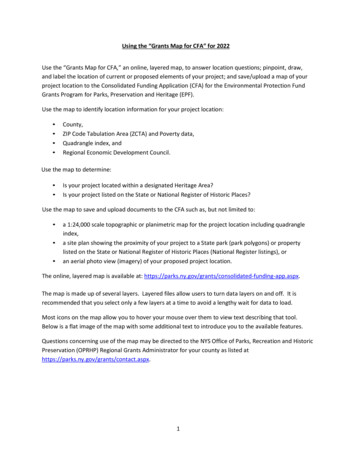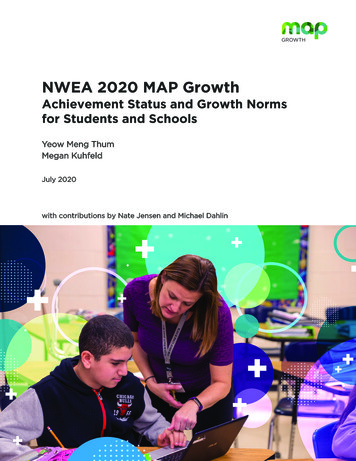
Transcription
NWEA 2020 MAP GrowthAchievement Status and Growth Normsfor Students and SchoolsYeow Meng ThumMegan KuhfeldJuly 2020with contributions by Nate Jensen and Michael Dahlin
SUGGESTED CITATION:Thum, Y. M., & Kuhfeld, M. (2020). NWEA 2020 MAP Growth Achievement Status and GrowthNorms for Students and Schools. NWEA Research Report. Portland, OR: NWEACOPYRIGHT 2020 NWEAAll rights reserved. No part of this document may be reproduced or utilized in any form or by anymeans, electronic or mechanical, including photocopying, recording, or by any information storageand retrieval system, without written permission from NWEA.NWEA and MAP are registered trademarks, and MAP Growth is a trademark of NWEA in the US andin other countries. The names of other companies and their products mentioned in this paper arethe trademarks of their respective owners.121 NW Everett Street Portland, OR 97209 866-654-3246 https://www.nwea.org
NWEA 2020 MAP GrowthAchievement Status and Growth Normsfor Students and SchoolsYeow Meng ThumMegan KuhfeldNWEAPortland, OregonJuly 20, 2020with contributions from Nate Jensen and Michael Dahlin
ForewordThe latest release (2020) of MAP Growth Norms comes at a pivotal time as educators in the U.S. andinternationally work tirelessly to address lost instructional time due to COVID-19 school closures. Asstate testing and college entrance exams came to a halt in Spring 2020, NWEA’s database, one of themost extensive longitudinal K-12 data sources in the world, is uniquely positioned to bring historical data tobear as important baselines. The public health crisis and recent civil movements also bring into relief longstanding opportunity gaps in our education system. We believe that interim data provided by assessments,such as the 2020 MAP Growth Norms, and national comparisons must be part of the solution in measuringour academic recovery efforts, identifying systematic inequities in our classrooms and schools, advocatingfor equity and inclusion, and promoting better outcomes for all of our children.Norms provide context to understand student and school achievement and growth in academic subjects. But how students performed or grew compared to an appropriate reference peer group also isimportant for individualizing instruction, setting achievement goals for students or entire schools, understanding achievement patterns and evaluating student performance. The concept of norms is relativelystraightforward - characterize each score in terms of its relative distance from other scores in a distribution of scores. However, the 2020 NWEA MAP Growth norming study reflects the application of anarray of statistical tools in order to fully leverage MAP Growth’s rich student longitudinal data for a betterunderstanding of learning trajectories.The latest norms include more recent national data but also highlight methodological and user enhancements. For example, we continued to refine the use of school calendars to better reflect the level ofinstructional exposure available to the student when she/he/they test. To improve the validity of normingresults, examinees who were not sufficiently engaged during the test were not included in the analyses.We have modeled the norms to be sensitive to the impact of summer breaks on learning. Finally, we havecalculated student-level norms and school norms jointly and include both in this study. The results areachievement and growth norms that improve utility, accuracy, and generalizability for educators, leaders,researchers, and policy makers.We note that norms reflect the performance of students and are sensitive to changes in student populations. Similar to trends observed with other datasets (e.g., National Assessment of Educational Progress(NAEP)), readers may notice differences in student status patterns from the prior MAP Growth Norms(Thum & Hauser, 2015). The MAP Growth scale remains stable, the measurement model for status andgrowth are valid and reliable, and the series of norming studies, while evolving and improving, has a firmfoundation from the outset on which we continue to build.With accompanying conditional growth percentiles, norms tell educators if students made growth consistent with their academic peers. Situating growth relative to students nationwide helps educators movebeyond the simple conclusion that a student either did or did not “make target growth” and understandthe extent and magnitude by which a student’s growth exceeded or lagged the growth observed for othersimilar students. Now, more than ever, is the time for educators, leaders, and families to (re)claim dataand take action to ensure that our most vulnerable students – including those from underserved com-i
munities, students of color, students with disabilities, English learners, and students experiencing fostercare, homelessness, or engaged in the juvenile justice system – have equitable access to the necessaryresources to reach their full potential. Because we cannot fix what we cannot measure, we believe in thepower of assessment to denaturalize rather than entrench structural opportunity gaps.NWEA is pleased to make this study available to you and eager to support our district partners andresearch colleagues in using and interpreting these norms in our shared quest to help all students learn.Dr. Beth Tarasawa, Ph.D.Executive Vice President of ResearchNWEAii
AcknowledgmentsAs with past efforts, the research on NWEA 2020 MAP Growth Norms has benefitted from the interest, contributions,and patience of many colleagues across the organization, attesting to the importance attached to this effort tosupport users of MAP Growth assessments. We feel confident that readers will find this document invaluable totheir understanding of how students attending U.S. public schools learn over time as measured by the NWEA MAPGrowth suite of assessments.The 2020 MAP Growth norming project began almost four years ago and gained momentum in Winter 2020when preliminary results were shared with colleagues in NWEA Product Management and Product Engineering tostage for delivery in reporting. Consultations with key Professional Development and Partner Accounts stakeholders, and major NWEA partners, occurred as this report rolled to its completion in Summer 2020.The authors are grateful for the leadership and support of Dr. Beth Tarasawa, Exec. V.P. of Research, throughoutthis period. Nate Young and Atticus Young assisted in the data collection effort to improve the accuracy of theinstructional calendar information. Nick Bonnichsen, Staff QA Engineer, has been key to re-fitting the 2015 versionof the Achievement Status and Growth Norms Calculator to accommodate the new results and functionality of thenew 2020 MAP Growth Norms.Many colleagues contributed to the reviewing process. The authors thank Debbie Baumam, Kelly Rivard, andJennifer Toothman for their copy-editing expertise. Content reviewers included John Cronin, Michael Dahlin, Laurence Dupray, Nate Jensen, Gage Kingsbury, Jim Soland, and Steve Wise. Carl Hauser took time out of hisretirement to lend his expertise and his wisdom. We believe that the additional chapter by Nate Jensen and MichaelDahlin will resonate well with many of our partners.At the conclusion of this project, our thoughts are also with our former colleague, Andy Hegedus. Always achampion of our MAP Growth district partners, Andy was a steadfast believer in the importance of normative metricsand relentlessly helping our educators appreciate the value of the Conditional Growth Index (CGI) for understandingthe performance of schools in their communities.Lastly, very special thanks are due to Ron Eberle for his expert management of all aspects of the project,including the internal reviewing process of the final document.Yeow Meng Thum, Ph.D.Megan Kuhfeld, Ph.D.July 20, 2020iii
About the AuthorsYeow Meng Thum is a Senior Research Fellow at the Collaborative for Student Growth at NWEA. His work focuseson methodological research on multivariate, multilevel models for behavioral and educational data, with a strongemphasis on methods for describing growth and change, as well as on topics in latent variable modeling, causalinference, and the psychometrics of scaling and norming. Dr. Thum holds a PhD from the University of Chicago.Megan Kuhfeld is a Senior Research Scientist at the Collaborative for Student Growth at NWEA. Her researchseeks to understand students’ trajectories of academic and social-emotional learning (SEL) and the school andneighborhood influences that promote optimal growth. Dr. Kuhfeld completed a PhD in Quantitative Methods inEducation and a master’s degree in statistics from the University of California, Los Angeles.iv
ContentsForeword . . . . . . . . . . . . . . . . . . . . . . . . . . . . . . . . . . . . . . . . . . . . . . . . . . . . . .iAcknowledgements . . . . . . . . . . . . . . . . . . . . . . . . . . . . . . . . . . . . . . . . . . . . . . . .iii1 Introduction . . . . . . . . . . . . . . . . . . . . . . . .1.1 Approach to MAP Growth Norms . . . . . . . . .1.1.1 Test Engagement . . . . . . . . . . . . . .1.1.2 Testing Schedule and Instructional Time1.1.3 Achievement Status and Growth Norms .1.1.4 Student and School Norms . . . . . . . .1.2 MAP Growth Norms and Research . . . . . . . .1.3 Common Classroom Uses . . . . . . . . . . . . .1.4 Outline of Report . . . . . . . . . . . . . . . . . . .1244577892 Items Pools and Instructional Time . . . . . .2.1 MAP Growth Assessments . . . . . . . . .2.1.1 Content Specification . . . . . . . .2.1.2 Scaling and Test Design . . . . . .2.2 Test Event Data . . . . . . . . . . . . . . .2.2.1 Time Span of Study Data . . . . .2.2.2 MAP Growth Scale Re-alignment .2.2.3 Eligibility Criteria . . . . . . . . . . .2.2.4 Selected Variables from the GRD .2.3 Instructional Exposure . . . . . . . . . . . .2.3.1 Instructional Calendars . . . . . . .2.3.2 Non-instructional Days . . . . . . .2.3.3 Calculation of Instructional Days .101010111213131314151616163 Target Population and Post-Stratification Weighting .3.1 Population and Sampling Design . . . . . . . . . . .3.2 School Weights . . . . . . . . . . . . . . . . . . . . . .3.3 School Challenge Index (SCI) . . . . . . . . . . . . .3.3.1 Data for SCI Construction . . . . . . . . . . .3.3.2 Imputing Missing Data . . . . . . . . . . . . .3.3.3 Estimation and Results . . . . . . . . . . . . .3.4 Constructing Post-stratification Weights . . . . . . .19191922232527304 Modeling Trends in Student Achievement . . . . . . . . . . . . . . . . . . . . . . . . . . . . . . .4.1 Student Longitudinal Data . . . . . . . . . . . . . . . . . . . . . . . . . . . . . . . . . . . . . . .3636.v.
4.2 Multilevel Growth Model . . . . . . . . . . .4.2.1 Compound Polynomials . . . . . .4.2.2 Norming Model Matrix . . . . . . .4.2.3 Using Scores as Outcomes . . . .4.2.4 Estimation . . . . . . . . . . . . . .4.3 Deriving Achievement and Growth Norms4.3.1 Achievement Status Norms . . . .4.3.2 Growth Scales and Growth NormsMarginal Growth Norms . . . . . .Conditional Growth Norms . . . . .4.4 School Intra-class Correlations . . . . . .4.5 Growth Measurement . . . . . . . . . . . . . . . . . . . . . . . . . . . . . . . . . . . . . . . . . . . . . . . . . . . . . . . . . . . . . . . . . . . . . . . . . . . . . . . . . . . . . . . . . . . . . . . . . . . . . . . . . . . . . . . . . . . . . . . . . . . . . . . . . . . . . . . . . . . . . . . . . . . . . . . . . . . . . . . . . . . . . . . . . . . . . . . . . . . . . . . . . . . .3839414243434444454646465 Achievement and Growth Norms for Students and Schools5.1 Compound Polynomial Growth Model Estimates . . . . . .5.2 Achievement Norms for Students and Schools . . . . . . .5.3 Growth Norms for Students and Schools . . . . . . . . . . .5.4 Conditional Growth Index and Percentile . . . . . . . . . . .5.5 Tables for Achievement Status and Growth . . . . . . . . .4848515558596 Norms and Educational Research . . . . . . . . . . . . . . . . . . . . . .6.1 Major Components of MAP Growth Norms . . . . . . . . . . . . . . .6.2 Multi-factor Continuous Norms . . . . . . . . . . . . . . . . . . . . . . .6.3 Measures and Their Scales . . . . . . . . . . . . . . . . . . . . . . . .6.4 Educational Performance Benchmarks . . . . . . . . . . . . . . . . . .6.4.1 ICCs for Achievement and Growth . . . . . . . . . . . . . . . .6.4.2 Grade-to-Grade Growth . . . . . . . . . . . . . . . . . . . . . .6.4.3 Scaling Years/Months of Instruction . . . . . . . . . . . . . . .6.4.4 Summer Learning Loss . . . . . . . . . . . . . . . . . . . . . . .6.5 MAP Growth and NAEP . . . . . . . . . . . . . . . . . . . . . . . . . . .6.5.1 Differences between the 2015 and 2020 MAP Growth Norms6.5.2 Comparing State-level MAP Growth and NAEP Results . . .6060646466676972747575767 Applications of MAP Growth Norms . . . . . . . . . . . . .7.1 Various Applications of the Norms . . . . . . . . . . . .7.2 Application of Achievement Norms . . . . . . . . . . . .7.3 Application of Growth Norms . . . . . . . . . . . . . . . .7.4 Considerations in the Application of the Norms . . . . .7.4.1 Setting Reasonable and Realistic Expectations7.4.2 Standard Error of Measurement . . . . . . . . .7.4.3 Instructional Weeks . . . . . . . . . . . . . . . . .7.4.4 When School Norms are Appropriate . . . . . .808081828484858687References . . . . . . . . . . . . . . . . . . . . . . . . . . . . . . . . . . . . . . . . . . . . . . . . . . . . .89Appendices . . . . . . . . . . . . . . . . . . . . . . . . . . .Appendix A - Student and School Status Norms . . .Appendix B - School and Student Growth Norms . . .Appendix C - School and Student Status Percentilesvi. 97. 97. 100. 109
Student . . . . . . . . . . . . . . . . . . . . . . . . . . . . . . . . .School . . . . . . . . . . . . . . . . . . . . . . . . . . . . . . . . .Appendix D - Student and School Conditional Growth DistributionsMathematics . . . . . . . . . . . . . . . . . . . . . . . . . . . . .Reading . . . . . . . . . . . . . . . . . . . . . . . . . . . . . . . .Language Usage . . . . . . . . . . . . . . . . . . . . . . . . . . .Science . . . . . . . . . . . . . . . . . . . . . . . . . . . . . . . .Appendix E - Student and School Conditional Growth Percentiles .Mathematics . . . . . . . . . . . . . . . . . . . . . . . . . . . . .Reading . . . . . . . . . . . . . . . . . . . . . . . . . . . . . . . .Language Usage . . . . . . . . . . . . . . . . . . . . . . . . . . .Science . . . . . . . . . . . . . . . . . . . . . . . . . . . . . . . .vii.110134158159184209229247248335422492
List of Figures2.1Instructional Calendar Example . . . . . . . . . . . . . . . . . . . . . . . . . . . . . . . . . 173.13.2SCI NWEA vs. Population . . . . . . . . . . . . . . . . . . . . . . . . . . . . . . . . . . . . 282015 SCI by State . . . . . . . . . . . . . . . . . . . . . . . . . . . . . . . . . . . . . . . . 294.14.24.34.4Illustrative Data Layout by Instructional Days . . . . . . . .Measurement of Growth in Grade 4 Mathematics . . . . .Illustrative Comparison of a Compound Polynomial ModelIllustrative Fitted CP Growth Model by Instructional Days.363839425.15.25.35.45.5Compound Polynomial Components of Predicted Means by Instructional WeeksPredicted MAP Growth Achievement Means by Grade and Term . . . . . . . . .Predicted Student Achievement Distributions by Grade and Term . . . . . . . . .Predicted School Achievement Distributions by Grade and Term . . . . . . . . .Conditional Growth Percentile (CGP) for Students and Schools . . . . . . . . . .50525354586.16.26.36.46.56.6School Grade-level Status and Growth Intra-class Correlations by Grade . . .Achievement Gains in Effect Size Metric . . . . . . . . . . . . . . . . . . . . . .Growth in Achievement with Instructional Exposure . . . . . . . . . . . . . . .NAEP and MAP Growth Trends for Grades 4 and 8 Mathematics and Reading2017 NAEP and MAP Growth State Grade 4 . . . . . . . . . . . . . . . . . . .2017 NAEP and MAP Growth State Grade 8 . . . . . . . . . . . . . . . . . . .6871737678797.1Spring-to-Fall Growth Norms by Achievement Percentiles-Grade 6 Reading . . . . . . . . 83viii.
List of Tables2.12.22.32.4Number of Items per Test by Content Area . . . . . . . . . . . . . .Norming Study Age Cohorts . . . . . . . . . . . . . . . . . . . . . . .Unduplicated Count of Districts, Schools, Students, . . . . . . . . .Means and Standard Deviations of Instructional Days of Test thetical Sample and Population Contingency Tables for Minority and FRL .Distributions of 2015-16 Categorical NCES Variables . . . . . . . . . . . . . . . .Distributions of Continuous Variables . . . . . . . . . . . . . . . . . . . . . . . . .2015 FCS Multiple Imputation Results . . . . . . . . . . . . . . . . . . . . . . . .Correlation between the SCI with Key Component (N 92033) . . . . . . . . . . .Impact of Post-stratification Weights . . . . . . . . . . . . . . . . . . . . . . . . .Post-stratification Weights for Mathematics Norms by Grade and SCI Decile . . .Post-stratification Weights for Reading Norms by Grade and SCI Decile . . . . .Post-stratification Weights for Language Usage Norms by Grade and SCI DecilePost-stratification Weights for Science Norms by Grade and SCI Decile . . . . .202425272831323334355.15.25.35.45.55.62020 RIT Norms Content Area Coverage . . . . . . . . . . . . . . . . . . . . . . . .Estimates of Fixed-effects, Student and School-level Parameter Standard DeviationEstimated Population Moments of Predicted Scores . . . . . . . . . . . . . . . . . .Status and Growth Norms: Relationship between . . . . . . . . . . . . . . . . . . .Term-to-term Gains: Means and Marginal Standard Deviations, and ICCs . . . . . .Term-to-term Conditional Growth Distributions . . . . . . . . . . . . . . . . . . . . .4849555656576.1Effect Sizes for Spring-to-Spring Growth in Mathematics, Reading, and Science7.17.2MAP Growth RIT Cut Scores that Predict . . . . . . . . . . . . . . . . . . . . . . . . . . . 82Student vs. School Norms Based on Example Scenarios . . . . . . . . . . . . . . . . . . 87A.1A.2Mathematics and Reading Achievement Status Norms . . . . . . . . . . . . . . . . . . . . 98Language Usage and Science Achievement Status Norms . . . . . . . . . . . . . . . . . 99B.1B.2B.3B.4B.5B.6B.7B.8Student Mathematics Growth Norms . . .School Mathematics Growth Norms . . .Student Reading Growth Norms . . . . .School Reading Growth Norms . . . . . .Student Language Usage Growth NormsSchool Language Usage Growth Norms .Student Science Growth Norms . . . . .School Science Growth Norms . . . . . . . . . . 70.101102103104105106107108C.1.1 Fall Mathematics Student Achievement Percentiles . . . . . . . . . . . . . . . . . . . . . . 110ix
C.1.2 Winter Mathematics Student Achievement Percentiles . .C.1.3 Spring Mathematics Student Achievement Percentiles . .C.1.4 Fall Reading Student Achievement Percentiles . . . . . .C.1.5 Winter Reading Student Achievement Percentiles . . . .C.1.6 Spring Reading Student Achievement Percentiles . . . .C.1.7 Fall Language Usage Student Achievement Percentiles .C.1.8 Winter Language Usage Student Achievement PercentilesC.1.9 Spring Language Usage Student Achievement PercentilesC.1.10Fall Science Student Achievement Percentiles . . . . . .C.1.11Winter Science Student Achievement Percentiles . . . . .C.1.12Spring Science Student Achievement Percentiles . . . . . . . .112114116118120122124126128130132C.2.1 Fall Mathematics School Achievement Percentiles . . . .C.2.2 Winter Mathematics School Achievement Percentiles . .C.2.3 Spring Mathematics School Achievement Percentiles . .C.2.4 Fall Reading School Achievement Percentiles . . . . . . .C.2.5 Winter Reading School Achievement Percentiles . . . . .C.2.6 Spring Reading School Achievement Percentiles . . . . .C.2.7 Fall Language Usage School Achievement Percentiles . .C.2.8 Winter Language Usage School Achievement PercentilesC.2.9 Spring Language Usage School Achievement PercentilesC.2.10Fall Science School Achievement Percentiles . . . . . . .C.2.11Winter Science School Achievement Percentiles . . . . .C.2.12Spring Science School Achievement Percentiles . . . . .134136138140142144146148150152154156D.1.1 Mathematics Grade K Conditional Growth DistributionsD.1.2 Mathematics Grade 1 Conditional Growth DistributionsD.1.3 Mathematics Grade 2 Conditional Growth DistributionsD.1.4 Mathematics Grade 3 Conditional Growth DistributionsD.1.5 Mathematics Grade 4 Conditional Growth DistributionsD.1.6 Mathematics Grade 5 Conditional Growth DistributionsD.1.7 Mathematics Grade 6 Conditional Growth DistributionsD.1.8 Mathematics Grade 7 Conditional Growth DistributionsD.1.9 Mathematics Grade 8 Conditional Growth DistributionsD.1.10Mathematics Grade 9 Conditional Growth DistributionsD.1.11Mathematics Grade 10 Conditional Growth DistributionsD.1.12Mathematics Grade 11 Conditional Growth DistributionsD.1.13Mathematics Grade 12 Conditional Growth 182D.2.1 Reading Grade K Conditional Growth DistributionsD.2.2 Reading Grade 1 Conditional Growth DistributionsD.2.3 Reading Grade 2 Conditional Growth DistributionsD.2.4 Reading Grade 3 Conditional Growth DistributionsD.2.5 Reading Grade 4 Conditional Growth DistributionsD.2.6 Reading Grade 5 Conditional Growth DistributionsD.2.7 Reading Grade 6 Conditional Growth DistributionsD.2.8 Reading Grade 7 Conditional Growth DistributionsD.2.9 Reading Grade 8 Conditional Growth DistributionsD.2.10Reading Grade 9 Conditional Growth Distributions.184185187189191193195197199201x.
D.2.11Reading Grade 10 Conditional Growth DistributionsD.2.12Reading Grade 11 Conditional Growth DistributionsD.2.13Reading Grade 12 Conditional Growth Distributions. . . . . . . . . . . . . . . . . . . . . 203. . . . . . . . . . . . . . . . . . . . . 205. . . . . . . . . . . . . . . . . . . . . 207D.3.1 Language Usage Grade 2 Conditional Growth Distributions .D.3.2 Language Usage Grade 3 Conditional Growth Distributions .D.3.3 Language Usage Grade 4 Conditional Growth Distributions .D.3.4 Language Usage Grade 5 Conditional Growth Distributions .D.3.5 Language Usage Grade 6 Conditional Growth Distributions .D.3.6 Language Usage Grade 7 Conditional Growth Distributions .D.3.7 Language Usage Grade 8 Conditional Growth Distributions .D.3.8 Language Usage Grade 9 Conditional Growth Distributions .D.3.9 Language Usage Grade 10 Conditional Growth DistributionsD.3.10Language Usage Grade 11 Conditional Growth 35237239241243245E.1.1 Mathematics Grade K Fall To Winter Conditional Growth Percentile . . . .E.1.2 Mathematics Grade K Fall To Spring Conditional Growth Percentile . . . .E.1.3 Mathematics Grade K Fall To N Fall Conditional Growth Percentile . . . . .E.1.4 Mathematics Grade K Winter To Spring Conditional Growth Percentile . . .E.1.5 Mathematics Grade 1 Last Winter To Winter Conditional Growth PercentileE.1.6 Mathematics Grade 1 Last Spring To Fall Conditional Growth Percentile . .E.1.7 Mathematics Grade 1 Last Spring To Spring Conditional Growth PercentileE.1.8 Mathematics Grade 1 Fall To Winter Conditional Growth Percentile . . . . .E.1.9 Mathematics Grade 1 Fall To Spring Conditional Growth Percentile . . . . .E.1.10 Mathematics Grade 1 Fall To N Fall Conditional Growth Percentile . . . . .E.1.11 Mathematics Grade 1 Winter To Spring Conditional Growth Percentile . . .E.1.12 Mathematics Grade 2 Last Winter To Winter Conditional Growth PercentileE.1.13 Mathematics Grade 2 Last Spring To Fall Conditional Growth Percentile . .E.1.14 Mathematics Grade 2 Last Spring To Spring Conditional Growth PercentileE.1.15 Mathematics Grade 2 Fall To Winter Conditional Growth Percentile . . . . .E.1.16 Mathematics Grade 2 Fall To Spring Conditional Growth Percentile . . . . .E.1.17 Mathematics Grade 2 Fall To N Fall Conditional Growth Percentile . . . . .E.1.18 Mathematics Grade 2 Winter To Spring Conditional Growth Percentile . . .E.1.19 Mathematics Grade 3 Last Winter To Winter Conditional Growth PercentileE.1.20 Mathematics Grade 3 Last Spring To Fall Conditional Growth Percentile . .E.1.21 Mathematics Grade 3 Last Spring To Spring Conditional Growth PercentileE.1.22 Mathematics Grade 3 Fall To Winter Conditional Growth Percentile . . . . .E.1.23 Mathematics Grade 3 Fall To Spring Conditional Growth Percentile . . . . .E.1.24 Mathematics Grade 3 Fall To N Fall Conditional Growth Percentile . . . . 64265266267268269270271Science Grade 2 Conditional Growth DistributionsScience Grade 3 Conditional Growth DistributionsScience Grade 4 Conditional Growth DistributionsScience Grade 5 Conditional Growth DistributionsScience Grade 6 Conditional Growth DistributionsScience Grade 7 Conditional Growth DistributionsScience Grade 8 Conditional Growth DistributionsScience Grade 9 Conditional Growth DistributionsScience Grade 10 Conditional Growth Distributionsxi.
E.1.25 Mathematics Grade 3 Winter To Spring Conditional Growth Percentile . . .E.1.26 Mathematics Grade 4 Last Winter To Winter Conditional Growth PercentileE.1.27 Mathematics Grade 4 Last Spring To Fall Conditional Growth Percentile . .E.1.28 Mathematics Grade 4 Last Spring To Spring Conditional Growth PercentileE.1.29 Mathematics Grade 4 Fall To Winter Conditional Growth Percentile . . . . .E.1.30 Mathematics Grade 4 Fall To Spring Conditional Growth Percentile . . . . .E.1.31 Mathematics Grade 4 Fall To N Fall Conditional Growth Percentile . . . . .E.1.32 Mathematics Grade 4 Winter To Spring Conditional Growth Percentile . . .E.1.33 Mathematics Grade 5 Last Winter To Winter Conditional Growth PercentileE.1.34 Mathematics Grade 5 Last Spring To Fall Conditional Growth Percentile . .E.1.35 Mathematics Grade 5 Last Spring To Spring Conditional Growth PercentileE.1.36 Mathematics Grade 5 Fall To Winter Conditional Growth Percentile . . . . .E.1.37 Mathematics Grade 5 Fall To Spring Conditional Growth Percentile . . . . .E.1.38 Mathematics Grade 5 Fall To N Fall Conditional Growth Percentile . . . . .E.1.39 Mathematics Grade 5 Winter To Spring Conditional Growth Percentile . . .E.1.40 Mathematics Grade 6
bution of scores. However, the 2020 NWEA MAP Growth norming study reflects the application of an array of statistical tools in order to fully leverage MAP Growth's rich student longitudinal data for a better understanding of learning trajectories. The latest norms include more recent national data but also highlight methodological and user en-



